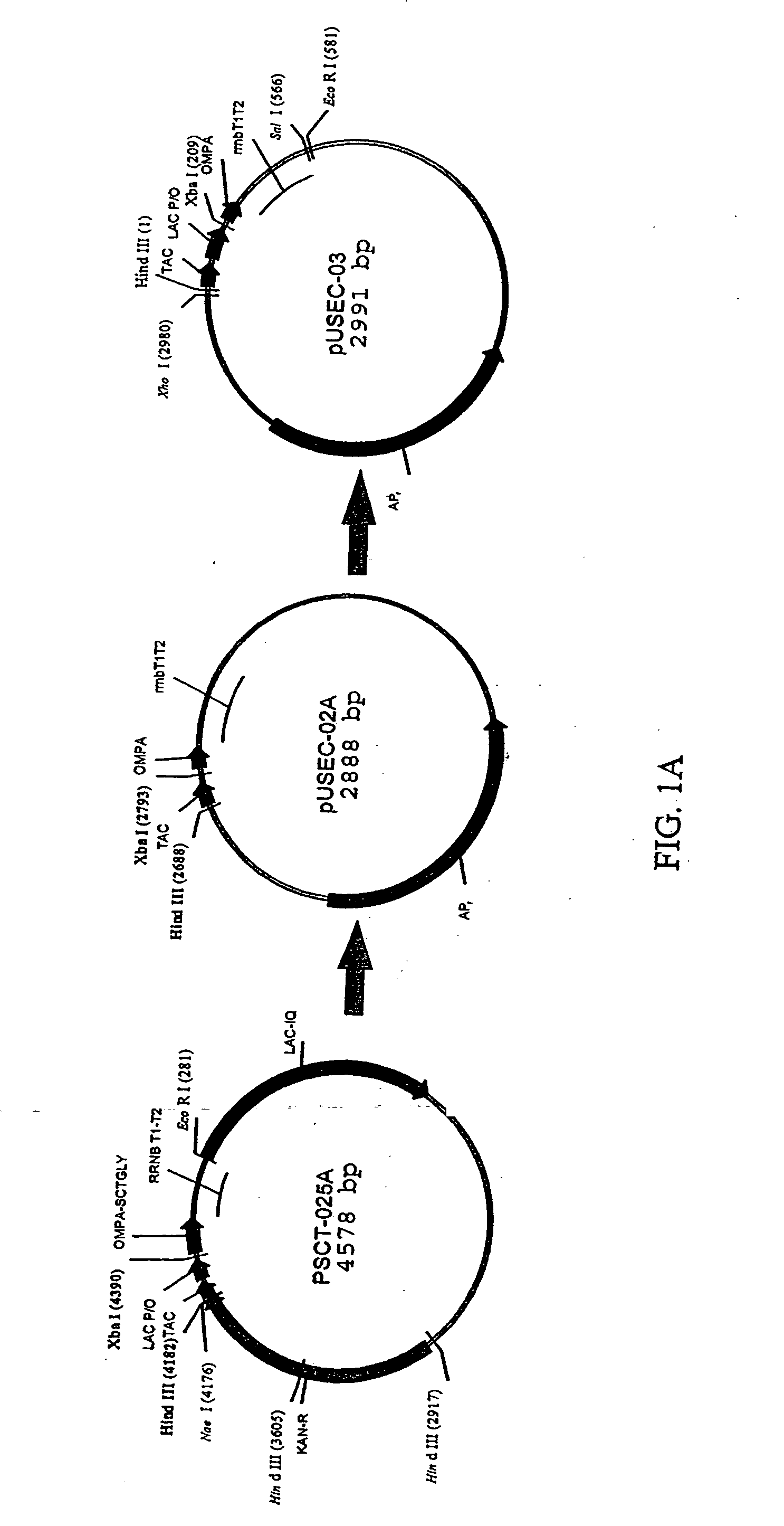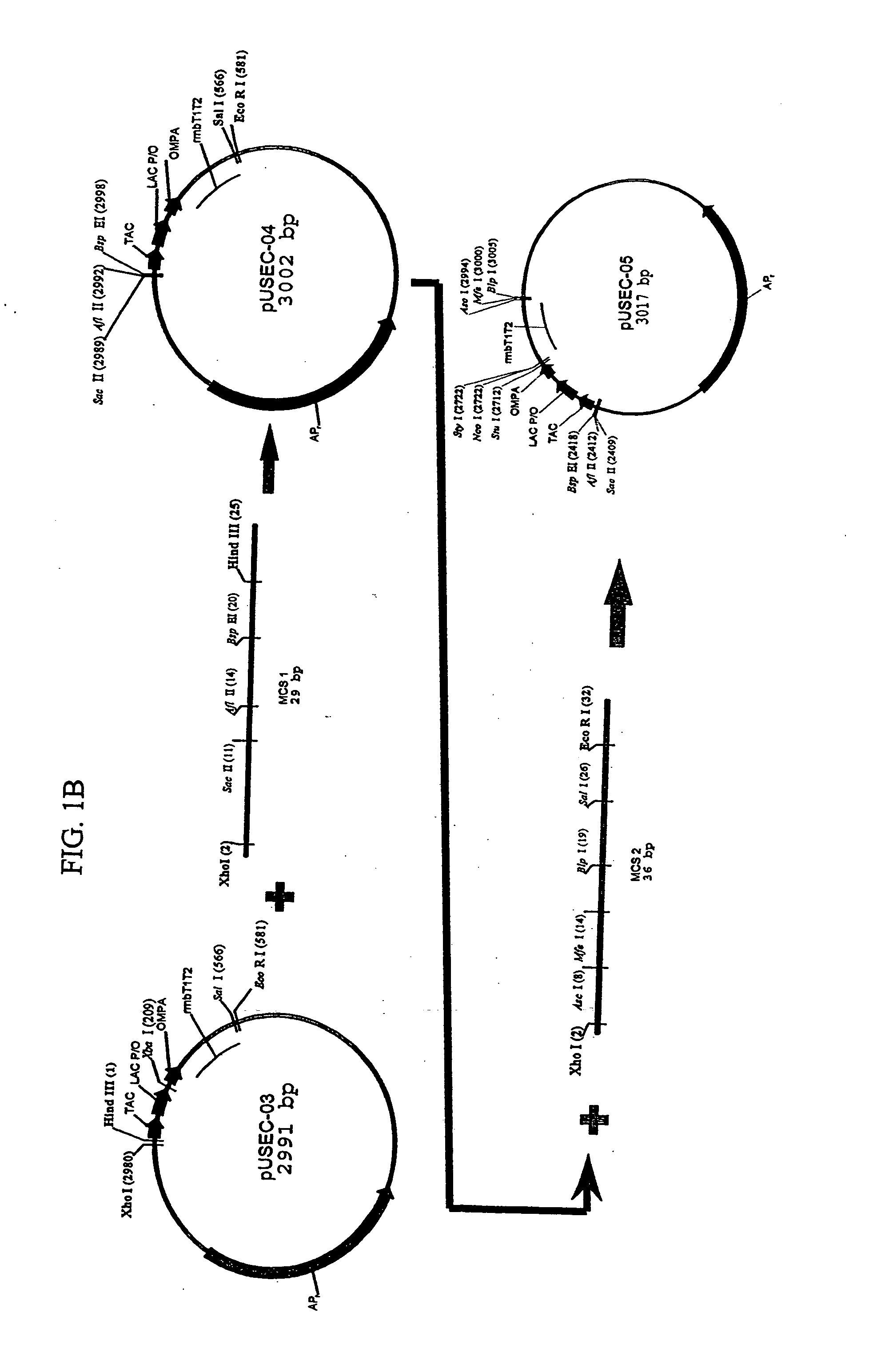Bacterial host cell for the direct expression of peptides
- Summary
- Abstract
- Description
- Claims
- Application Information
AI Technical Summary
Benefits of technology
Problems solved by technology
Method used
Image
Examples
example 1
Identification of Targzet Genes Responsible for Extracellular Peptide Product Degradation in Host Cells
SUMMARY
[0074] Applicants identified as described below an E. coli metalloprotease that is responsible for degradation of extracellular sCTgly at a rate of up to 25% per hr during the 18-26 hr post induction phase of the sCTgly direct expression fermentation protocol. Degradation of sCTgly is also present prior to 17 hr at an undetermined rate. Experiments detailed below indicated that the protease responsible for the degradation of sCTgly is protease III from the ptr gene of E. coli.
Introduction
[0075] Protease III is 107 kDa zinc metalloprotease that preferentially degrades peptides E. coli strain for elimination of Protease Im activity.
Proteolytic Degradation and Identification Degradation of sCTgly in Conditioned Medium
[0076] Conditioned medium samples from both UGL165 (E. coli BLR transformed with pSCT 029) and UGL703 (E. coli BLR transformed with pSCT 038) Direct Expres...
example 2
Construction of a Protease Deficient E. coli
Disruption of ptr and recA Function in E. coli BL21
[0088]E. coli BL21 was modified by introducing disruptions in the coding regions of the ptr gene, encoding Protease III, and the recA gene. Using P1 transduction, DNA from E. coli SF 103 was packaged in P1 bacteria phage and used to infect E. coli BL21 cells. The phage cell mixture was plated on LB agar plates containing chloramphenicol; only cells containing the chloramphenicol disrupted ptr gene should have the ability to grow in the presence of chloramphenicol. Ten chloramphenicol resistant transductants were also verified for BL21 genetic markers, such as the ability to grow on lactose and streptomycin sensitivity. The resulting strains BL21Δptr were further modified by P1 transduction with the E. coli strain BLR, which carries a recA− genotype. The tetracycline disrupted recA− gene from BLR was used for transduction of BL21Δptr creating a BL21 ptr− recA− strain. Twenty BL21 ptr- re...
example 3
Fermentation Protocol for UGL801
[0093] As indicated above, the plasmid vector, pSCT038, was used to transform the BLM-6 host strain to yield the UGL801 recombinant cell line. The development of optimized fermentation conditions for the new cell line, UGL801, began with the evaluation of the UGL801 cell line to produce sCTgly using the UGL703 Direct Expression conditions (the cell line, UGL703, is E. coli BLR harboring the plasmid pSCT038) : substrate limited fed batch fermentation run at 30° C., pH6.6, dO2≧70%, 26 hours of induced feed in a medium developed for UGL703. UGL703 in the initial DE fermentation protocol resulted in a volumetric yield of <200 mg / L and a specific yield of ˜1.3 mg of extracellular sCTgly per gram wet cell weight of cells. Host cell modifications resulted in the host cell, BLM-6, and the recombinant cell line, UGL801, which when tested under the UGL703 fermentation conditions showed ˜1.3× volumetric increase to greater than 200 mg / L at 26 hours post inducti...
PUM
| Property | Measurement | Unit |
|---|---|---|
| Temperature | aaaaa | aaaaa |
| Temperature | aaaaa | aaaaa |
| Time | aaaaa | aaaaa |
Abstract
Description
Claims
Application Information
 Login to View More
Login to View More - Generate Ideas
- Intellectual Property
- Life Sciences
- Materials
- Tech Scout
- Unparalleled Data Quality
- Higher Quality Content
- 60% Fewer Hallucinations
Browse by: Latest US Patents, China's latest patents, Technical Efficacy Thesaurus, Application Domain, Technology Topic, Popular Technical Reports.
© 2025 PatSnap. All rights reserved.Legal|Privacy policy|Modern Slavery Act Transparency Statement|Sitemap|About US| Contact US: help@patsnap.com



